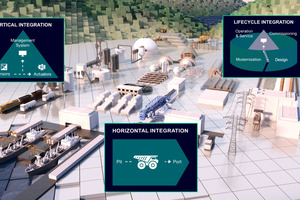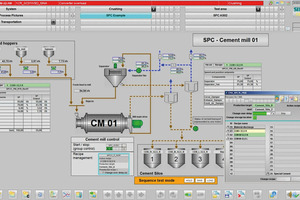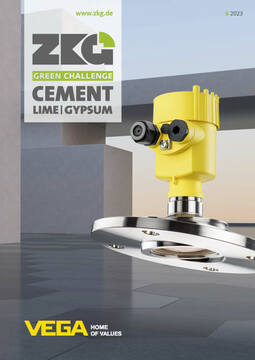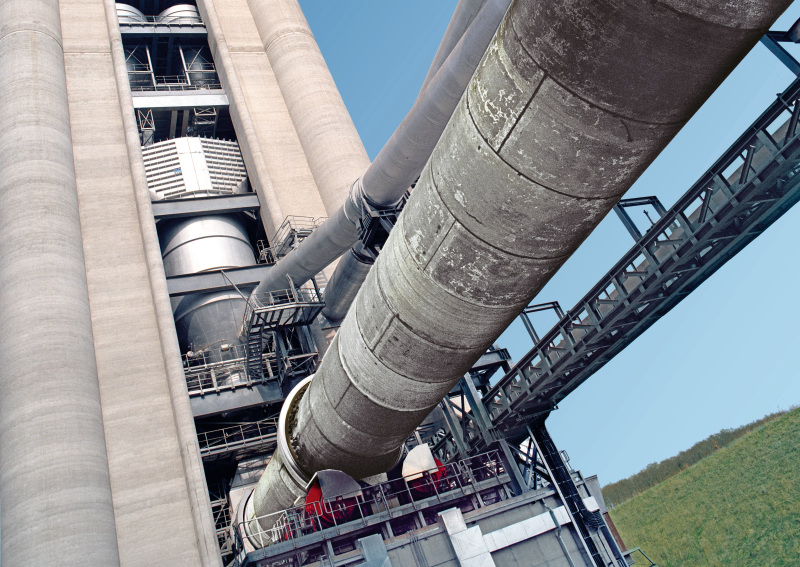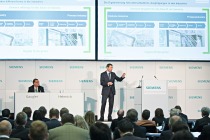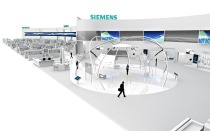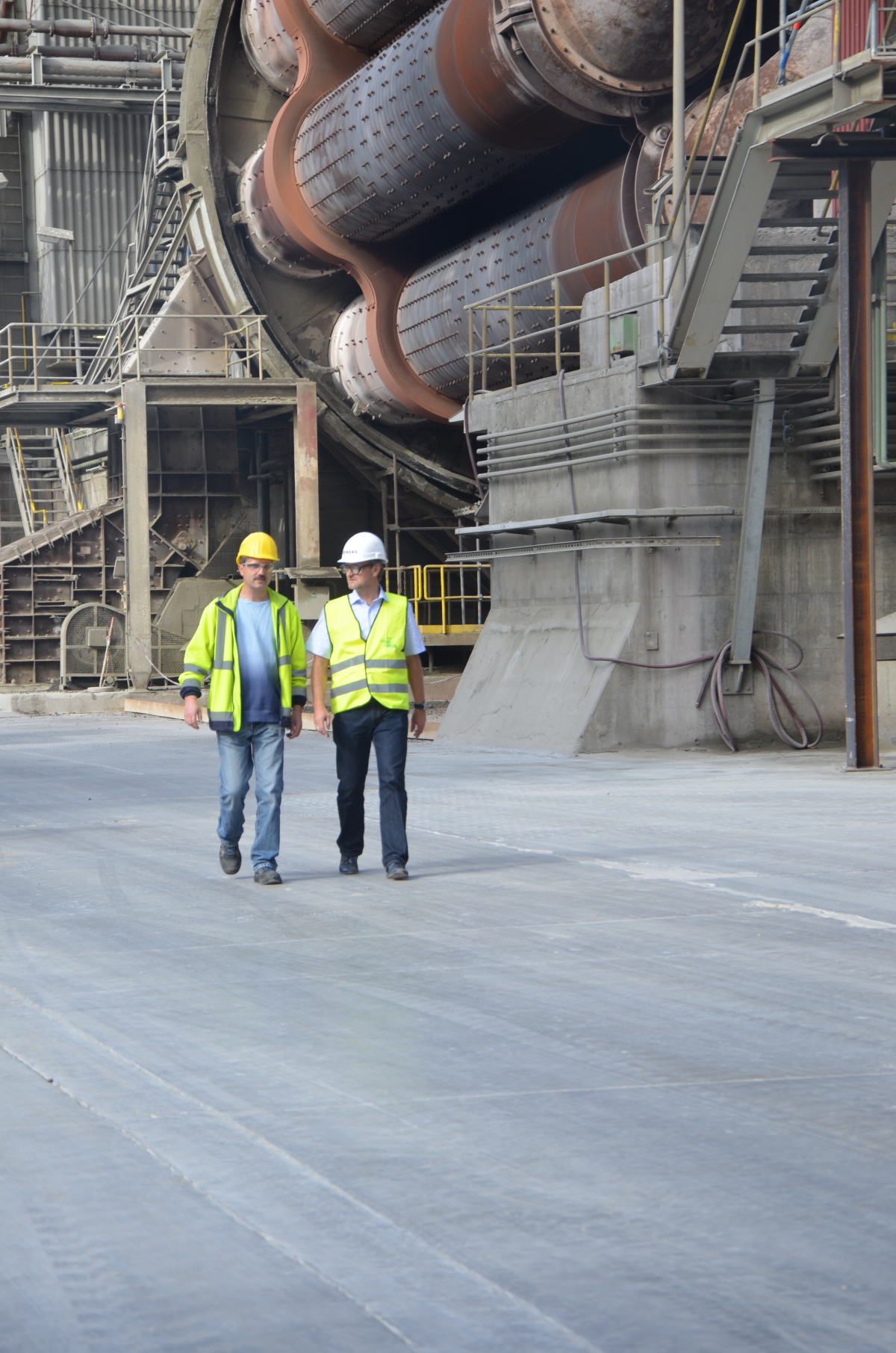Digital momentum for sustainable cement production
Latest-generation digitalization solutions can boost a cement plant’s efficiency while contributing significantly to the decarbonization of industry. To that end, the chain of production should be viewed based on a fully integrated approach: from the quarry to dispatch and even beyond, from the sensor/actuator to the management level and across a plant’s whole lifecycle. The result is a digital cement plant that is sustainable across the board, creates attractive jobs – and generates a good profit.
The construction industry accounts for around 38% of global CO2 emissions [1]. Thus, this whole industry bears a great responsibility to enhance the sustainability of its value chain. For quite some time now, sustainability has been a focus of the cement industry as a major sector of the construction industry. Because, as a matter of fact, climate-neutral construction is not possible without climate-neutral construction materials. Therefore, major global cement corporations have set themselves the goal of offering climate-neutral concrete in the coming years. The continuous optimization of products and processes is a major step on our path toward climate neutrality. Automation technology, and increasingly also digitalization, play a major role in this.
The ‘How’ is crucial
The cement industry can not just go on as before, according to the motto “business as usual”. To achieve ambitious climate goals, a change in mindset is the need of the hour. As well as courage and a culture of innovation. Large corporations in the industry are already cooperating with start-ups to develop new ideas. A comprehensive ecosystem is also paramount. It takes know-how and exchanges with various stakeholders such as research institutions as well as strong partners in the supply industry.
And last but not least: seeing digitalization as an opportunity. Processes have already been consistently automated in the last few decades. But the opportunities of digitalization have not yet been fully leveraged. It opens up new paths to making the cement production process more sustainable: Planning and production are becoming more and more closely interconnected. Data is turned into compact sources of information to even increase the optimization potential.
Setting a good example
Having been active in the cement industry for a long time as technology equipment providers, stakeholders such as Siemens want to set a good example in terms of sustainability: As a matter of fact, sustainability is a key element of the Siemens strategy. It is anchored in our daily business and guides our investment decisions and corporate governance.
Siemens take leadership towards decarbonization, with firm commitment to become carbon neutral by 2030. At the same time the comprehensive portfolio helps the cement industry to meet their individual decarbonization goals. Digitalization is one major element.
Integrated technologies with intent and purpose
Siemens offers a selected portfolio of interconnected hardware and software components, a powerful ecosystem of partners, as well as a comprehensive marketplace: Siemens Xcelerator. Siemens Xcelerator is an open digital business platform that enables customers to accelerate their digital transformation in line with the following motto: easier, faster and at scale.
Siemens Xcelerator creates an open ecosystem that allows co-creation between customers, Siemens, and certified partners ranging from the largest tech companies to independent software developers.
Like any local marketplace, this is where everything comes together. A selected, modular portfolio is already available. It includes IoT-capable software and hardware solutions as well as services based on standardized programming interfaces and interoperability, thus enabling the easy integration and maintenance of operations.
But this technology is of course not an end in itself. The portfolio is rather intended to be used in a target-oriented manner in order to provide technological solutions to the numerous challenges faced by cement producers today. CO2 emissions, safety and security issues, the shortage of skilled labor, environmental regulations and fluctuating prices, to mention just a few.
The three-pillar approach to the challenges of digitalization is as follows: lifecycle, horizontal and vertical integration.
Lifecycle integration focuses on addressing and optimizing the value chain across the whole lifecycle – from consulting, design and processes right up to production, and business operations as a whole. This concept secures the investment which was spent during the engineering phase of a plant and further utilize the information during the operation phase e.g. for maintenance purpose.
Horizontal integration covers the complete production process and goes from the quarry to cement dispatch and even beyond.
And vertical integration reaches from the field level via the automation level to the management level, thus connecting the dots between OT and IT. At this stage digitalization brings the two areas: OT and IT closer together. The tasks in both areas are different, but the challenge of cyber security remains in both. Cybersecurity for Industry ensures that customer know-how and plants are protected at all times. The multilayer Defense-in-Depth concept, which is strengthened by Zero Trust principles comprises all areas from the field level to the top management level.
Benjamin Franklin’s aphorism meets solid process automation
So consistent automation is a must and no longer an option. To achieve this, a plant-wide automation concept based on the Siemens process control system has proven extremely valuable: The cement-specific Cemat process control system has already been successfully deployed in the cement industry for almost 50 years now. In 1974, the first Cemat version based on the Simatic S3 programmable logic controller (PLC) was developed in close cooperation with global cement corporations. In line with technological progress, the system evolved further and further. Cemat was the first Windows-based process control system adapted to the needs of the cement industry. It has been based on the Simatic PCS 7 process control system since the year 2000. Cemat is available in various versions designed for different cement corporations; in the course of the years, these versions have been integrated into the Minerals Automation Standard. Thus, each corporation can pursue and implement its somewhat individual control philosophy.
The Cemat-specific, easy and intuitive handling enables highly efficient fault diagnosis as a basis for avoiding downtimes or at least keeping them as short as possible. Hence, Cemat pays off in a short time.
Many years ago, when the Digital Twin and plant simulation were still beyond imagination, Cemat already boasted integrated simulation functions for engineering and Factory Acceptance Tests (FAT): a major benefit in terms of the commissioning time required for whole plants and plant sections. Simply because Benjamin Franklin’s aphorism “Time is Money” is still true today. And many years of maintenance and further development of the Cemat software by the Siemens expert team also contribute to saving resources and money for Cemat users.
Thanks to the continuous evolution of the Cemat software, parameters for recipe-bound modes of operation can be saved, imported and exported, and adapted whenever required (“new cement type”). The integrated “Scalable Production Control” (SPC) module considerably facilitates recipe management at cement mills. Furthermore, the Materials Manager enables the flexible assignment of materials to storage sites.
The innovation journey goes on and on ... and the development of a Cemat version for the web-based Simatic PCS neo process control system is already underway. The first web-based process control system that will make it possible for engineers and operators to work on a secure, highly intuitive user interface. To ensure maximum plant and network security as well as system integrity, the Simatic PCS neo comes with various pre-configured security measures. The new control system enables multi-user engineering along with even simpler, but entirely secure remote access from any location worldwide.
The roadmap toward fully automated and autonomous systems
When it comes to remote systems, various maturity levels can be described: Expansion stages can be implemented depending on the business, technology and digitalization strategy of the individual cement plant. The spectrum reaches from the absence of remote services to a fully automated, autonomously operating cement plant. Siemens can support cement companies in increasing the maturity of their plants in a target-oriented manner: starting with basic automation for which, however, all the workers must operate the tools and software systems directly on site. The next expansion level focuses on combining monitoring and control activ-ities in one system which is located near the plants. When increasing the digital maturity even further, monitoring and support can be performed remotely, whereas operational and monitoring activities are still carried out at the plant on site. When taking the expansion to the next higher level, even operation and monitoring can be done remotely. No matter the expansion level, maintenance work is the only task that must still be completed on site. Once a plant has been fully automated to operate autonomously, only a small number of teams remain on site in order to supervise and maintain the plant in immaculate condition, as well as to carry out urgent work. The majority of employees observes and monitors plant sections remotely.
Special focus on sustainability aspects
Once the foundation for process automation has been laid, various software-based solutions can be implemented, for example to ensure energy transparency and efficiency. Simatic Energy Manager is an energy management system certified in accordance with ISO 50001. It enables the detailed representation of the energy flows and consumption values of cement and ancillary processes, as well as their assignment to cost centers. Therefore, it is simply ideal for assessing the efficiency measures implemented, optimizing energy procurement, and undertaking energy efficiency comparisons across plants and locations.
More and more purchasers of raw products such as cement request the manufacturer to provide information on the product carbon footprint (PCF).
Siemens has launched a solution for the efficient request, calculation and sharing of information on the true product carbon footprint (PCF):
Sigreen now makes it possible to exchange emission data along the supply chain and combine it with data from a company’s own value creation in order to obtain a product’s true carbon footprint.
To achieve this, Sigreen controls both the smart data exchange within the supply chain and the consolidation of emission data in one’s own company. This makes it easy for companies to determine the true product carbon footprint (PCF) of, for example, a bag of cement. Customers can verify the values submitted by their supplier: Via the latest-generation Blockchain technology, they can run a so-called automated “verifiable proof” and compare it with the supplier’s document for verification purposes. Since data is only exchanged on a decentralized basis and no central storage takes place, each party remains in full control of its own data.
Conventional PCF management tools calculate emissions on the basis of mean values that only provide static information. Sigreen, however, makes it possible to capture true up-to-date CO2 values as they occur on site, and aggregate them along the whole supply chain. The result is a dynamic PCF that supports cement plant operators in making confident, data-based decisions for measures that really do reduce the carbon footprint.
Digitalization provides fresh impetus to the cement industry
What might have seemed like a futuristic scenario just a few years ago has become reality today. Digitalization includes every aspect of the value chain in the cement process – from the quarry to transport and processing right up to storage and dispatch. Transport and logistics can be evaluated and integrated even beyond these aspects. Siemens sees itself as a holistic, strategic digitalization partner for the cement industry. Its consulting services can result in a digitalization roadmap that considers and assesses the specific needs and business models, as well as the existing infrastructure (IT & OT). The digital transformation can thus be rolled out according to plan. The roadmap includes ROI calculations in addition to digitalization options.
Processes can be optimized with each digitalization step. However, the greatest effect can be achieved by combining all the data generated in the corresponding area.
Example: Integrated engineering and operations
For new cement projects, virtual production is already factored in during the process and plant design phase, i.e. within the scope of the design, simulation and engineering of process plants. A digital twin of the plant and its automation can be created automatically on the basis of collaboration platforms and thanks to complete data integration: from the design to engineering and commissioning. With minimal effort, this digital twin can be used in real production, thus reducing engineering expenditure as well as the time until the start of production.
Comos plant engineering software facilitates the interaction between various disciplines while ensuring a consistent data flow. It provides all the relevant systems of a plant in one fully integrated data management platform. Comos redefines asset management: from maintaining a consistent flow of data and simplifying your documentation all the way to kickstarting virtual commissioning.
Since this also applies to the machine design, machine manufacturers can support cement plant operators through virtual twins in early phases, as well as during virtual commissioning and running operation.
PlantSight combines all the plant data and information, puts it into context, and validates and visualizes it. Thus, PlantSight combines and contextualizes all of a plant’s components and data – 1D, 2D, 3D or even nD data – and makes them easily accessible afterwards. The software merges the data generated during the engineering phase (e.g. plant dimensions, maintenance instructions, plant configuration) with real-time information (e.g. temperature, power consumption, quantity produced). PlantSight combines all the data sources into a consistent and complete image of the plant. All the users involved benefit from cloud-based access. PlantSight not only contributes to smooth cement plant operations; it also reduces cost-intensive repairs and time-consuming maintenance work.
The digital twin of the cement plant, including the simulation software, can also be used as a training tool. This facilitates the onboarding of new employees and creates attractive jobs.
Existing plants have often been equipped with the same hardware and software and have run the same processes for many years or even decades. However, it is nevertheless possible to leverage the significant advantages of the digital twin in order to optimize existing processes and assets. Plant-wide automation, complemented by an innovative plant engineering software solution, helps to break up information silos. Furthermore, refurbishments and maintenance can be performed on the basis of up-to-date, digitalized documentation and relevant operational data of the plant. This significantly reduces search times and errors – and confident decisions can be made based on reliable data. Once the digital twin has been created, integrated workflows are a key prerequisite for keeping it up to date across the plant’s entire lifecycle: Thus, the circle between virtual and real production can be closed. All this, as well as the simulation of optimization scenarios or future plant designs, supports cement companies in optimizing their plant’s performance and integrating their supply chains in the best possible manner. Because even suppliers and intralogistics can be integrated on the basis of a consistent collaboration platform.
Conclusion
No matter the level of maturity a cement plant operator has already reached or is striving for: Like no other company, Siemens combines its industry-specific cement knowledge accumulated over many decades with know-how on the field, automation and process levels up to the management level: as an all-in-one solution provider and across a plant’s whole lifecycle. The result is a “digital cement plant” that is sustainable across the board, creates attractive jobs – and generates a good profit.


